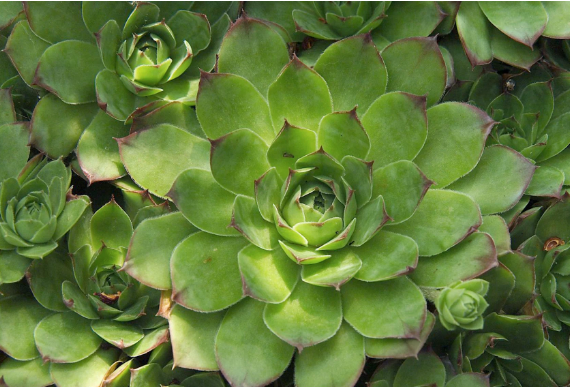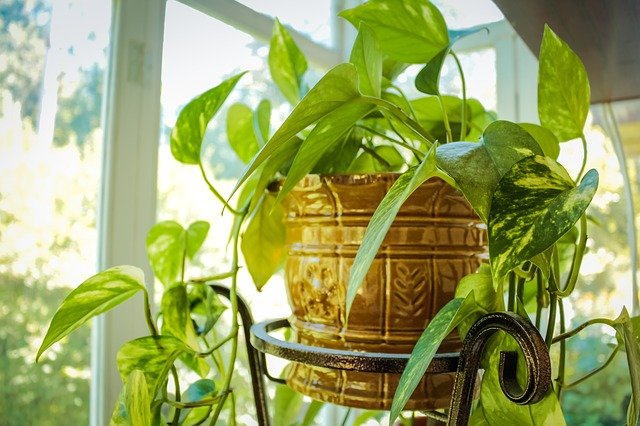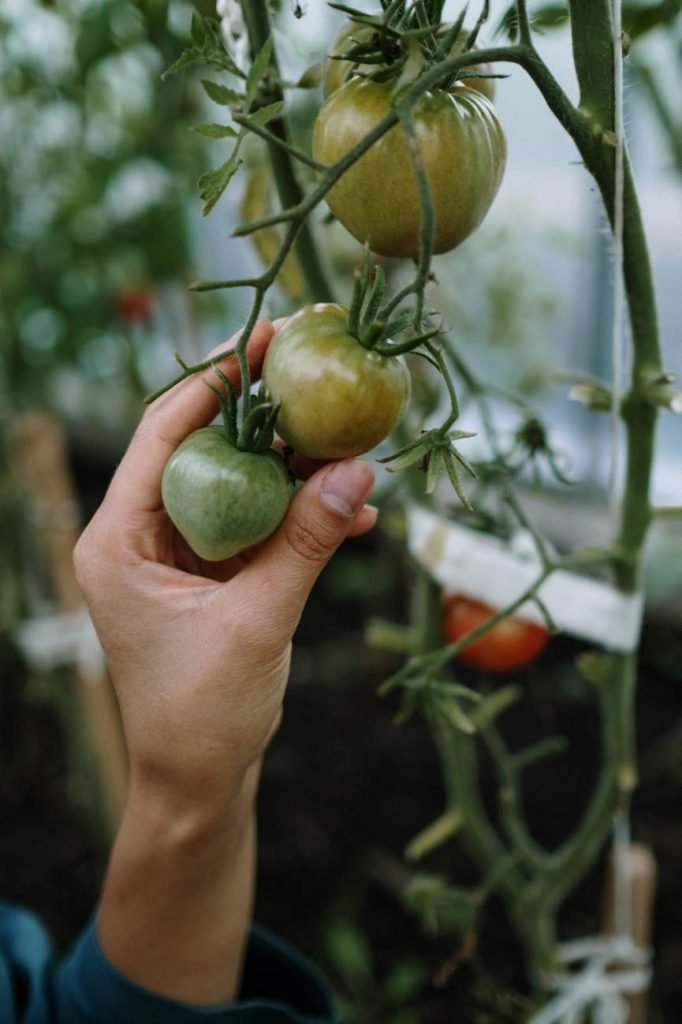With their ability to provide color and texture that can transform any bland space into a dreamy oasis, no wonder purple evergreen shrubs are among the most favored in the garden community. No matter what your main goal is, whether to fill in that empty area or to add a burst of color and texture, we’ve taken your homework to find the best evergreen shrub with purple flowers and leaves. Let’s jump in and take a closer look!
Table of Contents
Annual Evergreen Shrubs With Small Purple Flowers
Trailing Lantana Bush (Lantana Montevidensis)

Growing Zones: 8 to 10
No matter what the season is, these purple shrubs’ evergreen blossoms will remain intact. The trailing lantana bush is a fast-growing flowering plant with clusters of tiny lavender or purple blossoms, native to Southern America. They thrive the best as ground-covering plants where they can happily spread up to 6 feet (1.8 meters) or more.
Mexican Bush Sage (Salvia leucantha)

Growing Zones: 7 to 10
Attract butterflies and pollinators with these purple evergreen shrubs! Mexican bush sage is full of showy blossoms that thrive upright. They love bathing under direct sunlight but also benefit from the dappled light, which usually they get from the early afternoon hours. Under proper growing conditions, Mexican bush sage can grow up to 6 feet (1.8 meters) tall.
Cranberry Hibiscus (Hibiscus acetosella)

Growing Zones: 8 to 11
Consider thriving cranberry hibiscus if you’d like to incorporate edible plants into your nursery. Not only this evergreen shrub with small purple flowers would add more aesthetic value, but cranberry hibiscus is also packed with antioxidants, iron, calcium, and vitamins, making its leaves and flowers safe to consume. If you’re a fan of cooking, add petals of cranberry hibiscus to create that dramatic look on your culinary creations.
Perennial Flowering Purple Shrubs
Scotch Heather Bush (Calluna vulgaris)
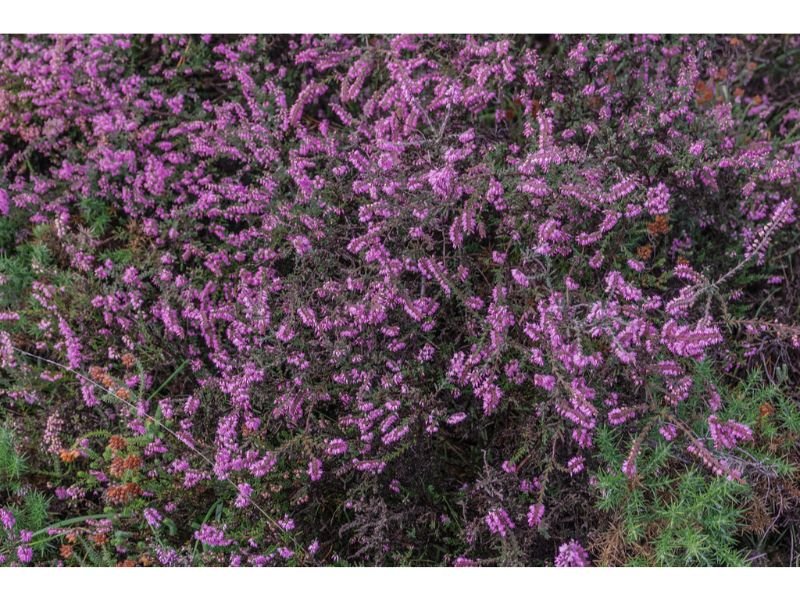
Growing Zones: 4 to 6
If you reside in cooler areas, scotch heather bush might be perfect for you. These purple evergreen shrubs are bees’ and pollinators’ favorite, and they’ve been blessed by the ability to thrive in acidic and poor soil, where most plants don’t. Scotch heather bush is not demanding when it comes to maintenance, just make sure to provide them with well-draining soil and lots of sunlight, and you’re good to go!
Lavender (Lavandula)

Growing Zones: 5 to 9
Whether you’re new to the world of gardening or not, we are sure you’d already know about this famous plant. Yes, lavenders are purple evergreen shrubs that are well-noted for both their eye-catching upright blossoms and plenty of health and beauty benefits. They also produce a strong fragrance that acts as a mosquito repellent. If you live in an area with a concerning population of mosquitoes, lavenders could be your new best friend.
Purple Dwarf Korean Lilac Bush (Syringa meyeri ‘Palibin’)

Growing Zones: 3 to 7
It’s hard to not fall in love with the tiny, tubular-shaped blossoms of the purple dwarf Korean lilac bush. Hardy in cold weather, this evergreen shrub with small purple flowers stays compact and would not mind thriving in smaller growing spaces like containers and pots. Their blossoms spark a fragrant smell, with a combination of sweet and earthy aromas.
Shade-loving Shrubs With Purple Leaves
Heuchera ‘Sugar Plum’

Growing Zones: 4 to 9
The good thing about growing these purple evergreen shrubs is you don’t have to worry about poor soil, cold, drought, and humidity, as they are happily tolerant to all those challenges. Heuchera ‘sugar plum’ is a variety of heuchera or coral bells that are famous for their roundish maple-like foliage and broad variation of hues.
Purple Chinese Fringe Flower Shrub (Loropetalum chinense)

Growing Zones: 7 to 10
Purple Chinese fringe flower shrub is a variegated genus of Loropetalum that remains compact and produces dark purple to burgundy leaves. They produce clusters of small, strap-shaped blossoms that are fragrant and range in color from bright reddish-pink, magenta, to white.
Purple Barberry Bush (Berberis thunbergii variegata atropurpurea)
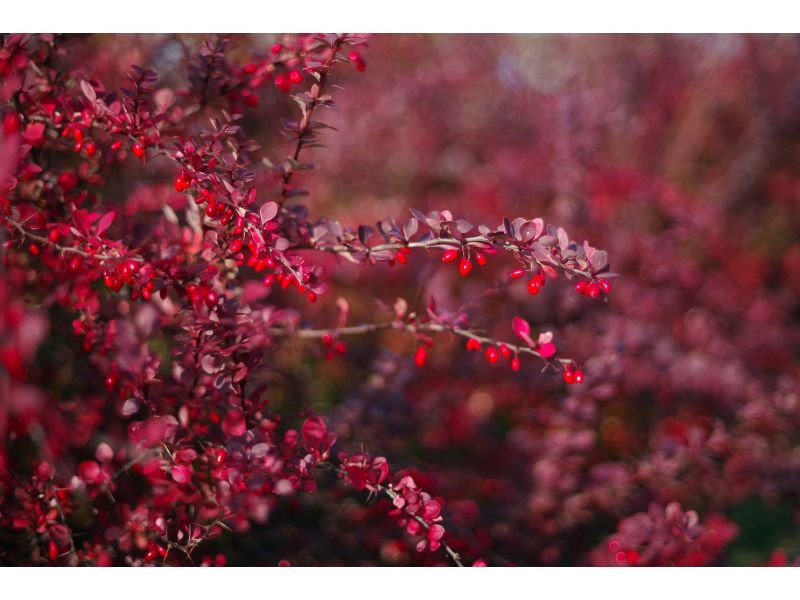
Growing Zones: 4 to 8
Purple barberry bush will adorn your garden with their tiny, oval-shaped foliage that looks incredible most notably in drought-tolerant gardens. These purple evergreen shrubs are known to be invasive and have been linked as the culprit of Lyme disease. Still, purple barberry bush captures many gardeners’ hearts with their spectacular looks and ease of growth.
Sun-loving Evergreen Shrubs With Purple Foliage
‘Lilla’ Smoke Bush (Continus coggygria ‘Lilla’)

Growing Zones: 5 to 9
Although the sap of the ‘Lilla’ smoke bush can cause mild skin irritation, it’s hard not to fall into these purple shrubs’ evergreen alluring beauty. Well, it’s easy to see why. ‘Lilla’ smoke bush has that mysterious dark purple foliage and is easy to grow in almost any soil type as long as it has a great drainage system.
‘Royal Purple’ Smoke Bush (Continus coggygria ‘Royal Purple’)
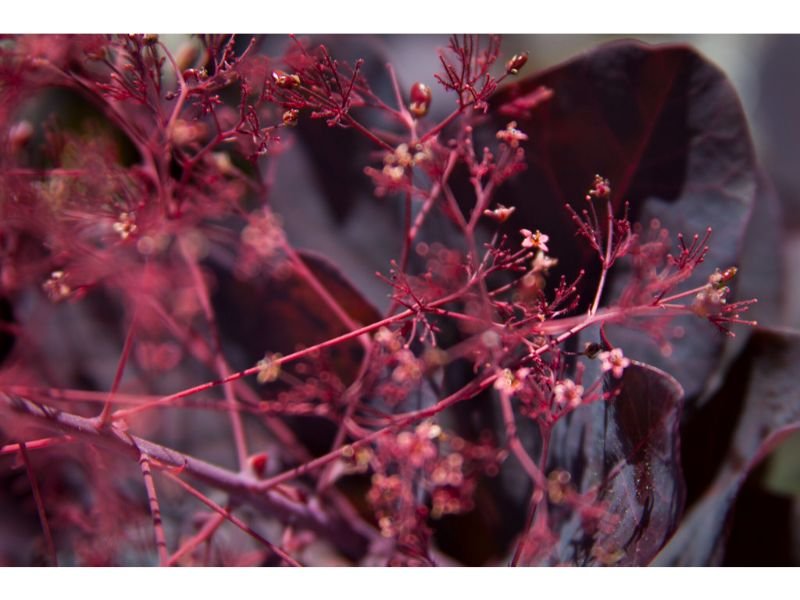
Growing Zones: 5 to 9
This one is another variation of the smoke bush, but unlike its ‘Lilla’ cousin, ‘Royal Purple’ produces much brighter purple foliage that is also available in burgundy-red color. In terms of maintenance, ‘Royal Purple’ smoke bush requires good drainage and tolerates a broad range of pH. It means whether your soil is acidic, alkaline, or neutral, this wouldn’t bother them.
Purple Leaf Sand Cherry (Prunus x Cistena)

Growing Zones: 3 to 8
These purple evergreen shrubs produce tiny cherry blossom-like flowers that make them perfect for Asian or Zen-themed gardens. Purple leaf sand cherry can be kept as a compact bush or smaller tree (e.g. bonsai) and wouldn’t mind thriving in containers or pots. However, they’re prone to pests and diseases such as Japanese beetles, aphids, and spider mites.
How Do Purple Shrubs Get Their Purple Color?
These purple evergreen shrubs get their color from pigments called anthocyanins, which are also responsible for blue and red hues in many plants. That’s why you’d likely see a plant ranging in color from lavender, and blue, to purple, as these beautiful colors are a byproduct of the same pigment. Nonetheless, external factors such as light, soil’s pH, temperature, and nutrients also play a role, which could make these purple evergreen shrubs appear more purple or red than it has to be.
Are Perennial and Evergreen Purple Shrubs the Same?
No, perennial and evergreen are not the same thing. Perennial refers to a plant’s life cycle, where they usually die back or go dormant during the cold season and then renew after the cold season or dormancy phase passes. Evergreen is a gardening term that is used to explain shrubs and trees that bloom all year round, no matter what the season is. A perennial could or could not be an evergreen and vice versa.
Purple Evergreen Shrubs: Final Thoughts
By incorporating these purple evergreen shrubs, getting a lush, colorful, and low-maintenance garden is surely not an impossible task. Consider their growth habit, and size, as well as your hardiness zone and soil conditions to minimize unwanted problems in the future. Happy Gardening!
Suggested articles:
- 7 Purple leaf shrub with pink flowers
- 12 Perennials with Purple Leaves
- Versatile Shrubs that grow in shallow soil

New author in the hood. Loves gardening and flowers are my spirit animals (yes I know they are not animals but I insist). I will be covering most of the flowers’ topics here and occasionally random though as well.



